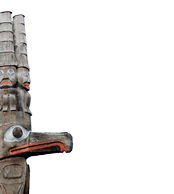 |
|||||||||
 |
|||||||||
 |
|||||||||

Wawadiťła, The Mungo
Martin House |
|
 Wawadiťła WawadiťłaMike Scott Photograph, RBCM Img0378 |
|
When it was constructed in 1941, Thunderbird Park featured a Northwest Coast style house with an inaccurate frontal painting produced especially for the building, as well as original carvings from many different First Nations, all put together in an inauthentic way. Mungo Martin, a Kwagu’ł artist from Tsaxis (Fort Rupert) who was considered the finest Kwakwaka’wakw carver of his day, made this new house in the park. Wilson Duff, the museum’s Anthropology Curator at the time, stressed that this house, unlike the previous one, was culturally appropriate and accurately portrayed First Nations traditions. Moreover, these were not dead traditions consigned to the past, but still active features of First Nations culture in British Columbia. “This house is more that just an authentic Kwakiutl house,” wrote Duff when the new house opened in 1953. “It is Mungo Martin’s house and bears on its house-posts hereditary crests of his family.” The current house contains two carvings that were made for it more recently: a log drum and a dance screen. They were created for the house by the artist, Richard Hunt, when he worked in the museum’s Carving Program. Richard is the son of Henry Hunt, Mungo Martin’s son-in-law, who worked with Martin in Thunderbird Park. The traditional hereditary rights to Wawadiťła are now the property of Martin’s grandson, Chief Oasťakalagalis ‘Walas ‘Namugwis (Peter Knox of Fort Rupert). On the occasion of the 50th anniversary of Wawadiťła in 2003, another great feast took place in the house, hosted over two evenings by Chief Peter Knox and the Royal BC Museum. Like the opening feast, this was attended by many First Nations and non-First Nations dignitaries. A poster celebrating the occasion was created by ‘Maxwa’yalisdzi (David Knox), Martin’s great-grandson. It featured a design based on the Copper Max’inuxwdzi (Great Killer Whale) that belonged to Martin and which he presented to the Royal BC Museum in 1960. Wawadiťła continues to be used for First Nations events with the permission of Peter and Mable Knox. It continues to be a place of meeting for urban First Nations people practising their cultures, as well as a place where non-First Nations people can learn about these living traditions. Interior features of the house are fully described in Late Era. Since that time, two carvings have been added. |
|
| Back to Map |
